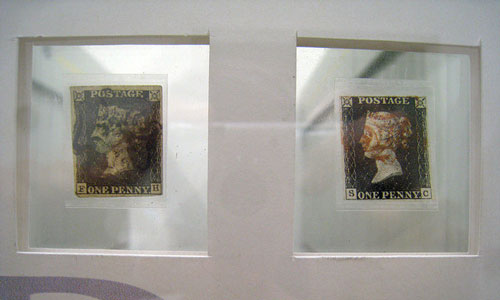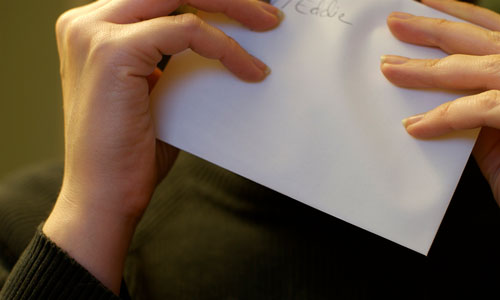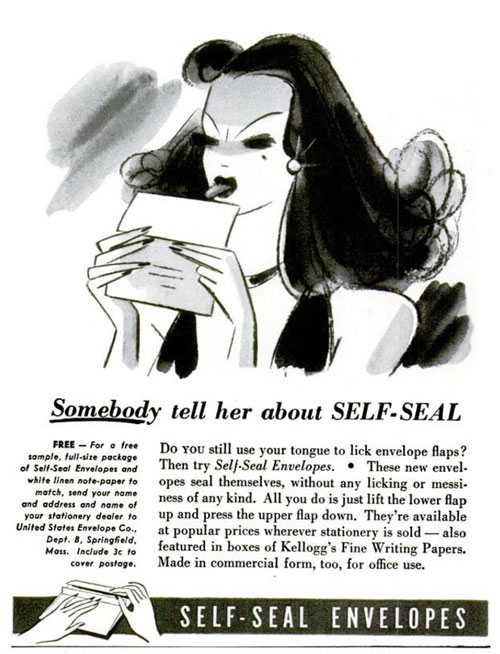Lickety Split
Why lick-on adhesives on letters maintain a market presence, despite being seemingly old-hat. (Well, except for stamps. We kinda gave up on ‘em there.)
“Mr. Fechheimer’s death was a singular instance of the dangers of blood poisoning, and his case is almost unparalleled in medical history. Saturday night, in sealing an envelope, he pressed the mucilaged portion of it across his tongue. The edge of the envelope was sharp and cut his tongue so that it bled a little. The next day, his tongue began to swell and pain him. The symptoms of a serious case of blood poisoning were manifest to the doctor who was called to Mr. Fechheimer’s hotel Sunday.”
— The New York World, writing about the 1895 death of Sigmund Fechheimer, a man who apparently came down with blood poisoning after cutting his tongue on an envelope. The story was reported widely at the time—The New York Times featured the situation in a small blurb , giving the situation a little more weight than it had otherwise, when the World’s lurid yellow journalism reputation was near its peak. It was likely a surprise for Richard Fechheimer when he discovered the truth of what happened to his distant relative when looking into his genealogy—now posted at the Internet Archive.

The famed Penny Black stamp. (tehhen/Flickr)
How the first lickable adhesive stamp used on a mass scale made it easier to deliver mail
Sending a letter is no big thing nowadays, but before the 19th century, it was a horribly complicated process in the United Kingdom, consuming a whole lot of extra time and based on a postage system driven by distance.
Fortunately, a man with an interest in both adhesive and simplifying the mail for the average person saw a way forward. That man is Rowland Hill, and in 1837, he released a booklet titled Post Office Reform: Its Importance and Practicability. The booklet proved hugely influential on improving the situation around the mail.
Of the many ideas he brought up in his discussions of ways to improve the mail system to make it accessible to the average person was the idea of the adhesive stamp. From his booklet, with key points highlighted:
Persons unaccustomed to write letters, would, perhaps, be at a loss how to proceed. They might send or take their letters to the Post Office without having had recourse to the stamp. It is true that on presentation of the letter, the Receiver instead of accepting the money as postage, might take it as the price of a cover, or band, in which the bringer might immediately inclose the letter, and then redirect it. But the bringer would sometimes be unable to write. Perhaps this difficulty might be obviated by using a bit of paper just large enough to bear the stamp, and covered at the back with a glutinous wash, which the bringer might, by applying a little moisture, attach to the back of the letter, so as to avoid the necessity for re-directing it.
Of the many ideas that Hill brought forth to fix the British mail system, this turned out to be the most noticeable and lasting. He had solved many of the complications of routing a letter by making it possible for the letter-sender to pre-pay the postage. The letter was proof that the postage price was already covered.
Just a few years after pushing this idea forward, this idea had its moment in prime time, with the formative stamp called the Penny Black, a tiny illustration of Queen Victoria that followed this moistenable strategy. During the first year alone, 68 million Penny Black stamps were applied to pieces of mail throughout the United Kingdom.
There are some prior claimants to the adhesive stamp concept, as laid out by stamp expert Ken Lawrence during the days of Usenet, but the Penny Black was a turning point both for stamps in general and the idea of licking (or at least moistening) a piece of paper so it could apply to another piece.
But this nonetheless introduced the concept of “gumming” stamps, most commonly with substances like dextrin (a derivative of starch), and polyvinyl alcohol. These days, stamps tend to be self-adhesive—in other words, no licking—but the same can’t be said about letters in many cases.
1.7
The number of calories, per gram, that gum arabic generally has, according to a Food and Drug Administration estimate most recently updated in 2008. Gum arabic is a fairly common substance, a major commodity from Sudan that’s used in everything from sodas to candy bars. It’s also used in many envelope adhesives, giving the glue the sickly sweet flavor you either hate or secretly love. One fascinating thing about this that that there are websites out there that have attempted to count the number of calories consumed when licking an envelope or a stamp. Fat Loss School suggests an envelope has around a thousandth of a gram of gum arabic, while DietFacts estimates that a U.S. postage stamp accounts for a tenth of a calorie. The U.K. Royal Mail, in one estimate to The Guardian, says that its stamps range from 5.9 calories to 14.5 calories. Don’t fill up on stamps.

Five interesting misconceptions about adhesives on letters
- There’s long been a belief among the health-conscious that letter adhesives have gluten—a fact that the Envelope Manufacturers Association specifically denies on its FAQ page. “Remoistenable adhesives are derived from corn starch and do not contain wheat or rye gluten,” the association emphasizes.
- Likewise, envelope and stamp adhesive is almost always vegan, as it’s made from synthetic materials, per the UK Royal Mail. That said, if you’re vegan and in the market for designing your own adhesive, I definitely don’t recommend this guide.
- For years, a rumor has floated around the internet that licking envelopes could help spread cockroach eggs. This is entirely false, but on the other hand, PETA notes that envelope glue can provide useful nutrients to cockroaches, along with other kinds of substances that you wouldn’t eat, like paint or bar soap. Desperate times call for desperate measures.
- Yes, your DNA sticks with the envelopes. Gerald Lehman, a Michigan soldier who was stationed at Pearl Harbor, had not been identified for decades after his death aboard the USS Oklahoma. But in 2010, he was identified properly, after a letter he had sent to his mother was checked for Lehman’s DNA. It was found on the stamp. A similar technique was being used to help identify Amelia Earhart’s remains, with less luck thus far. Nonetheless, the potential has given philately a kick in the pants in recent years.
- Self-adhesive stamps didn’t come about from the United States, but Sierra Leone. The problem there, notes Linn Stamp News writer Janet Klug, was that the humidity was so high that traditional stamps would’t work so well—making self-adhesive stamps a good idea there. Bringing them to the U.S. proved challenging—a failed attempt in 1974 led the U.S. Postal Service to avoid making another variation for 15 years. Fortunately, that one stuck.

An ad for the Self-Seal envelope from a 1941 edition of Life Magazine. (Google Books)
So why does lick-friendly envelope adhesive stick around, anyway?
It seems weird that in an age where we have so many better options for adhesives that envelopes are still mostly stuck in the days when tongues do most of the work.
What’s the reason for that? To put it simply, the direct mail industry loves remoistenable adhesives, which work really well for machines that ship out direct mail en masse.
“Remoistenable front seals reactivate with moisture and are the most common in use today due to their suitability for automatic inserting machines,” the Envelope Manufacturers Association explains in a recent guide.
In other words, no, the direct mail industry does not have an army of people looking to lick messages, but rather they use a variety of approaches to get the same result.
For direct mailers, a lot of variables go into the decision making process for spitting out perfect pieces of mail in bulk, including how much the seal curls, how well the seal handles humidity, and how the adhesive bonds to the paper.
And not all approaches are created equal. As the New York Times bestselling book Adhesives and Sealants: Technology, Applications and Markets explains, a process called hot-melt extrusion—which involves placing a hot adhesive directly onto the letter, has gained prominence within the industry because the end result is often more professional looking than simply moisturizing the adhesive on the envelope, as the goobers do it.
“Hot melts can be applies much more precisely than water-based systems and give a very polished and professional look with no curling of paper,” author David Dunn writes. “Conversely, water-based adhesives often look dull, have rough edges, and tend to curl the paper because moisture is added to only one side of the sheet.”
The consumer market has long benefited from solutions that take some of the annoyance out of a truly tedious task. The Life Magazine ad above, for instance? It’s from 1941. But mass-mailers have completely different needs, which means you’re not going to get rid of licking envelopes anytime soon—even if there’s not any actual licking going on.
*- OK, not really.
Direct mailers take their adhesives seriously. In 2001, for example, immediately after the anthrax attacks at facilities around the country, direct mail companies looked to find ways to make their adhesives stronger.
But the truth is, the reason why adhesive envelopes persist in the consumer market is because they imply “personal touch,” like the words you say mean slightly more because you imperfectly closed this envelope.
In recent years, companies like Thankbot and Bond have come along to challenge our thinking about what constitutes hand-written. At some point, the mindset around hand-written cards won’t mean quite as much anymore.
Does that mean we can start texting our birthday wishes to people instead and leave the cards (and their adjoining materials) out of it?
:format(jpeg)/2017/04/tedium041117.gif)
/2017/04/tedium041117.gif)

/uploads/ernie_crop.jpg)